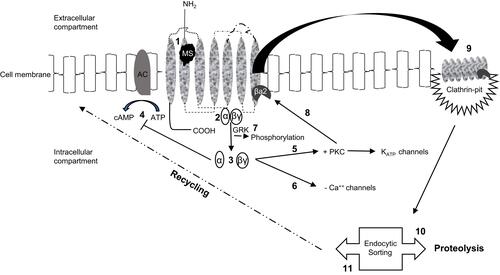Figures & data
Figure 1 Schematic rendition of the opioid receptor-signaling pathways. Morphine (MS)-binding (1) to a monomeric receptor initiates intracellular signaling by activating the trimeric G-protein (2) and causing dissociation of α- and βγ-subunits (3). The G-protein subunits can promote different cellular responses such as α-inhibition of adenylyl cyclase and the generation of cAMP (4) or βγ- induction of protein kinase C (PKC)-mediated stimulation of K+ channels (5) or inhibition of Ca++ channels (6). Notably, ligand-bound receptors lacking the G-protein subunits are functionally desensitized by GPCR kinase (GRK)-induced phosphorylation (7). PKC prompts recruitment of β-arrestin-2 (βa2) (8) driving receptors to clathrin-coated pits which enable the endocytic process (9). Further sorting of the internalized receptors affects cellular signaling in additional ways. Receptors marshalled to lysosomes (10) are degraded while receptors sorted to endosomes may undergo rapid recycling to the cell surface, effectively re-sensitized (11) and able to be activated again.

